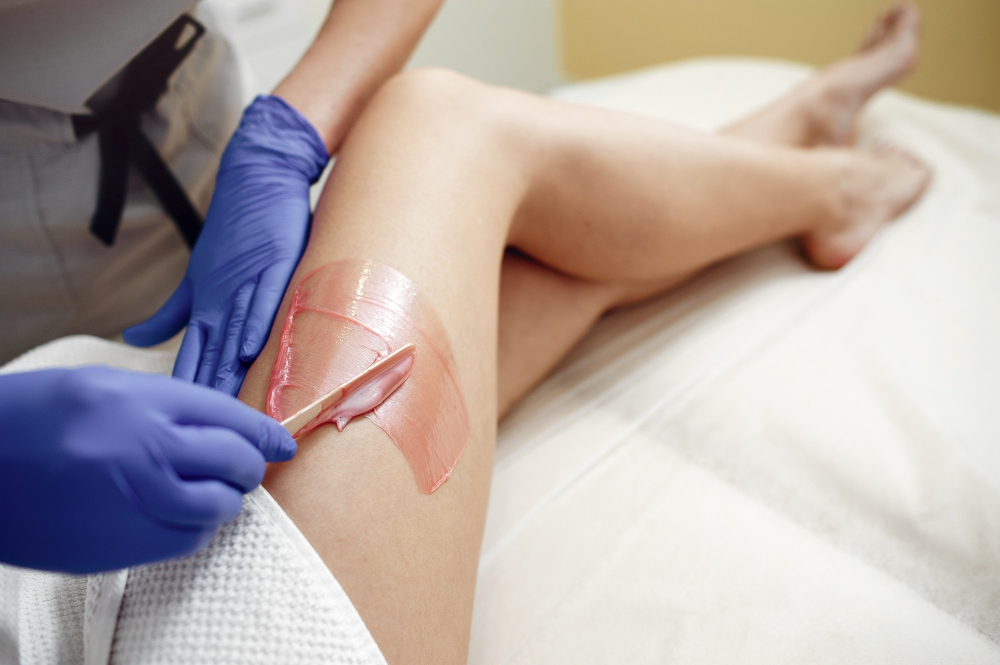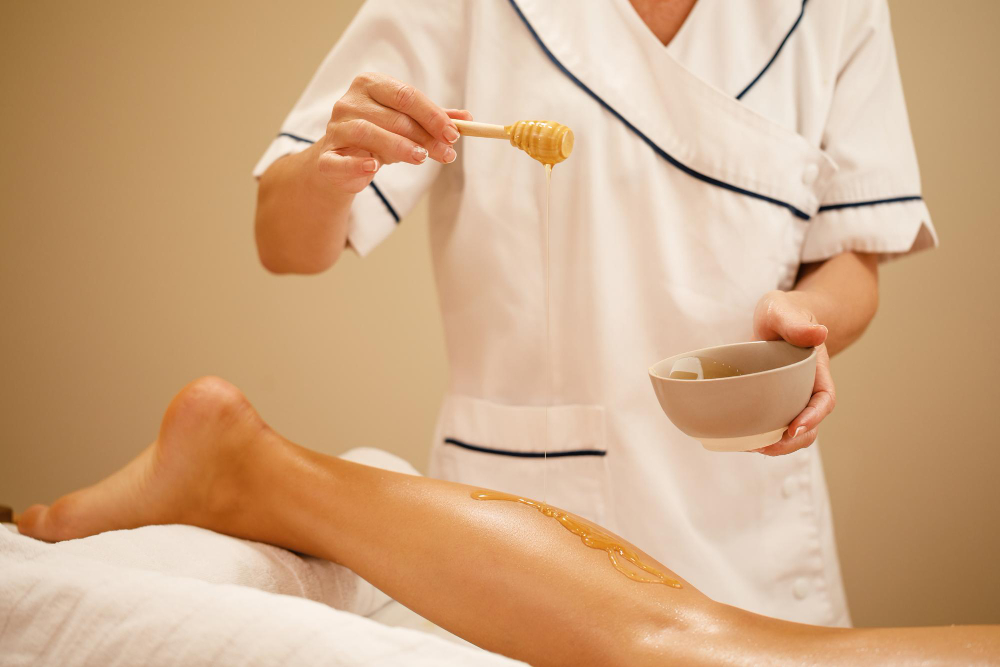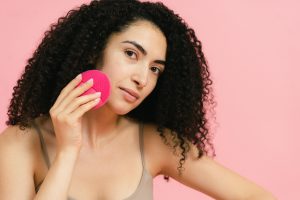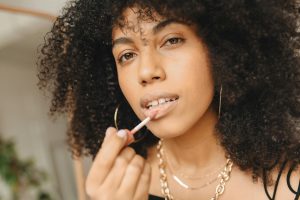Whether you’re a novice to hair removal or just looking for an alternative to your current method, sugaring and waxing are two popular options. But how do you know which one is right for you? Sugaring and waxing may seem similar, but they have critical differences in ingredients used, application techniques, and aftercare tips.
This article will explore the pros and cons of each option so that you can make an informed decision about which is best for your needs. It will also provide helpful tips on what to expect before, during, and after either procedure.
- What Is Sugaring?
- What Is Waxing?
- Key Differences Waxing vs. Sugaring
- Pros and Cons of Sugaring vs. Waxing
- What should you do before your appointment?
- What happens during the appointment?
- How is Sugaring or Waxing Done?
- Sugaring vs. Waxing Aftercare
- Tips for Post-Hair Removal Care
- How to Prevent Ingrown Hairs After Sugaring or Waxing
- When to Schedule Your Next Appointment
- Are there any side effects or risks to consider?
- How to Minimize Ingrown Hairs and Bumps?
- Who Can Get Sugaring and Waxing?
- Cost Comparison: Sugaring vs. Waxing
- Sugaring vs. Waxing: Which One Takes Longer For The Hair To Grow Back?
- Sugaring vs. Waxing Frequently Asked Questions
What Is Sugaring?
To remove hair from the root, a sugar paste made of sugar, lemon, and water is used in sugaring. This hair removal technique has been used since ancient Egypt and is often mistaken for waxing, although it is different. The sugar paste is applied against the direction of hair growth and then quickly pulled off in the same direction. Salons now offer sugaring as a service, and the process involves using a sticky syrup made from ingredients like sugar, lemon, and water to pull out the hair.
What Is Waxing?

The process of waxing removes hair from the root using a sticky substance like wax. This substance is applied to body hair and then removed, pulling out the hair from the follicle. After waxing, it takes four to six weeks for the hair to grow back in the same area. However, some people may see regrowth in as little as one week due to variations in their hair growth cycle.
Key Differences Waxing vs. Sugaring
To clarify, for sugaring, the sugar is applied against the direction of hair growth and removed in the same direction as hair growth. On the other hand, waxing is applied in the direction of hair growth and removed against the direction of hair growth. It is important to note that these differences in technique can lead to varying results.
Ingredients Used in Sugaring and Waxing
Sugaring uses natural ingredients like sugar, lemon, and water to remove hair from the root. Waxing typically involves a sticky substance from synthetic materials like resin or polymer. Depending on the salon offering the service, these ingredients can range from organic to non-organic.
Consistency and Application Method
Sugaring involves applying the mixture in the direction opposite to hair growth and then removing it. To wax, use in the direction of hair growth and pull in the opposite direction.
Pain Level and Discomfort
This is subjective, as each person’s pain threshold differs. Generally speaking, sugaring will likely result in less discomfort than waxing since the paste does not stick to the skin as much and can be removed quickly. Waxing may cause more discomfort because it sticks to the skin and must be pulled off forcefully.
Effectiveness in Hair Removal
Both methods are effective in removing hair from the root. However, sugaring may be more effective as it is gentler and can even remove finer hairs. Waxing may not pull out shorter, finer hair due to its adhesive properties.
Pros and Cons of Sugaring vs. Waxing
When considering either hair removal method, there are various pros and cons. Knowing these in advance will help you make an informed decision on which one is best for you.
Benefits of Sugaring
Sugaring offers numerous benefits that can outnumber waxing benefits. For instance, sugaring can make your hair grow softer and thinner, mainly if you do it frequently. It can also cause less irritation compared to waxing. Additionally, sugaring is a simple process that entails applying and cleaning up a water-based paste that effortlessly washes out of clothes. If there is any leftover residue on your skin, you can remove it using water.
Sugaring repeatedly can exfoliate the top layer of the skin, and since hair is removed in the same direction it grows, it is less painful. This product promotes natural skin healing and eliminates the need for strips or spatulas, resulting in minimal waste.
Benefits of Waxing
Waxing also offers benefits for people who want to use the process. Waxing can be done more quickly than sugaring since it involves using a pre-made wax that does not need to be prepared. Additionally, this method may cause less redness and irritation since the wax does not stick as much on the skin as the sugaring paste. Waxing may be more effective for people with coarse or long hair as it can grab stubborn hair.
Drawbacks of Sugaring
While sugaring may be less irritating than waxing for your skin, you should still expect some inflammation or irritation. Removing too many skin cells may also lead to sore or irritated spots. Additionally, it is recommended for anyone taking isotretinoin (a medication to treat severe cystic acne) to wait at least six months after they finish the prescription before undergoing sugaring.
It is important to avoid treating any skin that is inflamed or infected. Furthermore, if you use irritating topical medications like tretinoin for treating skin conditions like acne, you should stop using them for at least a few days before the treatment. You may want to avoid this treatment if you have eczema, highly sensitive skin, or skin that tends to darken due to irritation.
Drawbacks of Waxing
When waxing, you may experience redness and irritation around the area that has been treated. This is especially true if the person performing the procedure does not follow the proper technique or applies too much pressure when pulling off the wax. Additionally, skin discoloration may occur due to broken capillaries, especially on sensitive areas like your face. Waxing can also lead to ingrown hairs, especially if the wax is not applied or removed correctly.
What should you do before your appointment?
No matter which method you choose, it is crucial to prepare for the appointment. Ensure your skin is clean, exfoliated, and free of lotions or creams. Avoid waxing or sugaring for at least two weeks before your treatment to get the best results. Trimming long hairs on areas like your legs or bikini line to about 1/4 of an inch is also recommended for the most effectiveness.
If you opt for waxing, you may want to know the answer to the question, “Is there a body wax near me?” If there’s one, you should know how to differentiate Brazilian vs. bikini wax.
What happens during the appointment?

During your appointment, the practitioner will apply wax or sugar paste and then quickly remove it toward hair growth, pulling out the hairs from their follicles. Depending on the treated area, the process usually takes about 10 to 15 minutes.
You can opt for hard or soft wax in a waxing salon. Hard wax is applied in one layer, while soft wax is applied in multiple layers. You may see the hairs removed as they come out of their follicles.
How is Sugaring or Waxing Done?
Sugaring is a hair removal method that is similar to waxing. It involves using a mixture called paste, made of lemon, water, and sugar. The paste is heated until it becomes like candy and is then applied to the skin. This method is considered more natural and eco-friendly than waxing.
On the other hand, waxing involves applying a sticky substance like resin or polymer to the body hair and then quickly removing it, pulling out the hairs from the follicles. After waxing, the hair usually takes four to six weeks to grow back in that area.
Sugaring vs. Waxing Aftercare
After either treatment, taking appropriate care of your skin is important. Taking care of your skin prevents irritation, ingrown hairs, and discomfort.
Tips for Post-Hair Removal Care
After either sugaring or waxing, it is essential to be gentle with your skin. Avoid hot tubs and swimming pools for at least 24 hours after the appointment since these irritate the skin. Additionally, limit exfoliation in that area, as this could cause further irritation.
How to Prevent Ingrown Hairs After Sugaring or Waxing
Keeping the area clean and moisturized is vital to prevent ingrown hairs after sugaring or waxing. Gently exfoliate a few times per week to remove any dead skin cells that could clog up your pores. Additionally, use an aftercare product designed for hair removal to soothe and protect the skin. Finally, wear loose-fitting clothing to avoid friction or irritation in the treated area.
When to Schedule Your Next Appointment
Depending on the person, hair regrowth can vary. For some, it may take one to two weeks for the hair to grow back in the same area, while for others, it could take up to a few months. Generally speaking, waiting at least four weeks before scheduling your next sugaring or waxing appointment is recommended.
Are there any side effects or risks to consider?
Sugaring and waxing are two popular hair removal options that can be used to remove hair from the root. However, there are side effects and risks when choosing either option.
When it comes to sugaring, there may be some inflammation or irritation caused by removing too many skin cells. Those with eczema or susceptible skin may want to avoid this treatment altogether.
Waxing can cause redness and irritation around the area that has been treated. This is especially true if the person performing the procedure does not follow the proper technique or applies too much pressure when removing the wax. Additionally, skin discoloration may occur due to broken capillaries, and ingrown hairs can form if not done correctly.
How to Minimize Ingrown Hairs and Bumps?
To minimize ingrown hairs and bumps, it is essential to exfoliate the area regularly with a gentle scrub. This will help remove dead skin cells that could be clogging your pores and causing ingrown hairs. To prevent ingrown hairs, refrain from tweezing, shaving, or picking stray hairs post-appointment. You can also use an oil or concentrate for additional prevention.
Who Can Get Sugaring and Waxing?
Sugaring and waxing suit most people, regardless of skin type or tone. However, there are some things to consider before you proceed with sugaring or waxing for hair removal.
Skin Type and Sensitivity

For people with sensitive skin, opting for a gentle option like sugaring is best, as waxing may cause more irritation. Additionally, those taking certain medications or having certain health conditions should consult their doctor before their appointment. It is also essential to be mindful of the ingredients in either product and consider choosing natural options if possible.
Pregnancy
If you are pregnant, you should consult your doctor before getting either treatment. Additionally, inform the practitioner performing the treatment you are expecting so they can take appropriate precautions.
Menstruation
It is generally recommended to avoid waxing or sugaring during your menstrual cycle. This is because skin sensitivity increases during this time, which can make the treatment more painful. You may also want to wait a few days after your period ends since your hormones will still fluctuate.
Skin Conditions and Allergies
Those with skin conditions such as eczema, psoriasis, or rosacea should not get waxing or sugaring done. Additionally, those who are allergic to the ingredients used in either method may want to avoid these treatments altogether.
Genital Piercings
If you have genital piercings, informing the practitioner before your appointment is crucial. This will help them use the appropriate technique and pressure when removing the hair and avoid any potential irritation or complications due to the piercing.
Cost Comparison: Sugaring vs. Waxing
If you’re considering a Brazilian wax or sugaring, the cost will typically range from $50 to $70, depending on your location and the provider’s experience. However, deciding between the two methods will depend more on factors such as skin allergies and hair growth stage since the cost difference isn’t too significant.
Factors That Affect the Cost
The cost of sugaring or waxing may vary depending on the size and area being treated. Additionally, certain salons may charge more if they use organic or natural ingredients in their products, while some may offer discounts for larger areas like the legs. Some salons also offer package deals, so it is worth looking into before making an appointment.
Average Cost of Sugaring and Waxing
Generally speaking, the average cost of sugaring and waxing is between $50 and $70 per session. However, prices may vary slightly depending on the provider and location.
Which is more cost-effective in the long run?
Over time, sugaring may be more cost-effective than waxing due to its gentler and less irritating nature. As the hair grows back thinner, you may need fewer treatments in the future. Waxing may require more appointments since it is not as effective on finer hairs. Additionally, waxing can cause more irritation and discoloration in the long run. Ultimately, this may mean more money is spent on treatments and products to repair the skin over time.
Which Hair Removal Method Should You Choose?
When deciding which hair removal method is best for you, it is crucial to consider factors such as skin type, sensitivity, and hair growth stage. Sugaring may be the best option for sensitive skin since it causes less irritation than waxing. Waxing may be more effective for those with coarse or longer hair since it can grab stubborn hair.
It is best to consult with a professional before making your decision. They can help determine which method will be most suitable for you and provide tips on how to get the best results. These professionals can help you answer, “Is sugaring better than waxing?”
Additionally, make sure to take appropriate care of your skin before and after treatment to reduce any inflammation or irritation. With the right preparation and aftercare, you can enjoy smooth, hair-free skin all year round!
Personal Preferences
Your preferences and comfort level should be considered when choosing a hair removal method. If you are uncomfortable with waxing due to irritation or pain, sugaring may be a better option. On the other hand, waxing might be the better choice if you prefer the quickness of waxing or simply do not like the idea of using a sugary paste.
Whatever method you choose, it is essential to research and take care of your skin before and after the appointment. With the proper preparation and aftercare routine, you can ensure your hair removal experience is as smooth and effortless as possible!
Hair Growth Patterns
It is also essential to consider the hair growth patterns in the area you are treating. If a particular area has more stubborn or curly hairs, waxing may be more effective than sugaring. Alternatively, sugaring may be better suited for that specific area if the hair is finer since it can quickly grab onto shorter hairs.
Time and Convenience
Finally, when deciding which method to use, you should think about the time and convenience of each. If you are short on time or cannot make regular appointments, waxing may be more convenient since it can take less time than sugaring. This way, you’ll know exactly how long your appointment will accept and won’t have to worry about making multiple appointments for the same area.
Sugaring vs. Waxing: Which One Takes Longer For The Hair To Grow Back?
Sugaring and waxing are both effective hair removal methods, but sugaring may take longer for the hair to grow back in certain areas. This is because sugaring can pull out finer hairs that waxing cannot always grab onto. Conversely, waxing can remove thicker hairs more quickly since it pulls them from their root.
Overall, both methods will take time for the hair to grow back, and it is recommended that you wait at least four weeks between treatments to ensure maximum results. You can enjoy smooth, hair-free skin all year round with proper preparation and aftercare!
Sugaring vs. Waxing Frequently Asked Questions
Can You Do Sugaring or Waxing at Home?
It is possible to do sugaring or waxing at home, but it is not recommended. Practitioners have the experience and knowledge of both methods, so they will be able to determine which one is suitable for you and use the proper technique.
How Long Will the Results Last?
The results of both sugaring and waxing can last up to four weeks, depending on the person. However, this can vary due to hair growth rate, skin type, and lifestyle.
Does Sugaring or Waxing Cause More Ingrown Hairs?
Both sugaring and waxing can cause ingrown hairs. However, it is more likely to occur if the practitioner does not follow the proper technique or applies too much pressure when removing the hair.
Is Sugaring or Waxing Painful?
The pain felt during sugaring or waxing can vary from person to person. Generally speaking, sugaring is less painful since it gently removes the hair.
Can You Get Sugaring or Waxing During Pregnancy?
It is generally not recommended to get sugaring or waxing during pregnancy. It is best to consult with your doctor before making an appointment and inform the practitioner what you expect to take appropriate precautions.
Do Sugaring or Waxing Cause Skin Damage?
Both sugaring and waxing can cause skin damage if not done correctly. Waxing may cause more irritation due to its harsher nature, while sugaring may remove too many skin cells and lead to inflammation or redness.
Overall, both sugaring and waxing are effective hair removal methods that come with their benefits and risks. When deciding which method is best for you, it is crucial to consider factors such as skin type, sensitivity, allergies, cost-effectiveness in the long run, time constraints, and personal preferences. Consulting a professional before making your decision can help ensure you get the most suitable treatment for your needs. Additionally, make sure to take appropriate care of your skin before and after treatment to reduce any inflammation or irritation. With the right preparation and aftercare routine, you can enjoy smooth, hair-free skin all year round!









